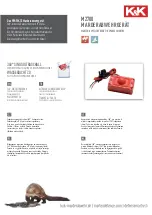
ID61/62 Series Panel - Installation, Commissioning & Configuration Manual
Commissioning
24
997-457-000-8, Issue 8
January 2010
4.4 External Wiring Checks
The following sections describe the procedures for
checking and connecting the external wiring:
a. See
Section 4.4.1, Loop Wiring
1
,
b. See
Section 4.4.2, RS485 Communications Link
,
c. See
Section 4.4.3, DC Auxiliary Output
,
d. See
Section 4.4.4, Sounder Circuit Outputs A and B
,
e. See
Section 4.4.5, CFG Outputs C and D
,
f. See
Section 4.4.6, -VE Outputs
, and
g. See
Section 4.4.7, Digital / ÜE Inputs
.
4.4.1 Loop Wiring
Typical connections of analogue addressable loop device
to a loop are shown below.
Checks Before Connection
To check the Loop wiring:
1
For CLIP devices link out any isolators on the Loop
by temporarily shorting terminals 2 and 4 on each
isolator. For OPAL protocol-compatible sensor bases
(B501 AP) remove the device from the base. These
bases have +leg terminals (+2 and +4) that short
automatically when the sensor is removed. Check
Appendix 1 of this manual or the LBC for OPAL device
types with fitted internal isolators.
2
These tests should then be carried out using a low-voltage
multimeter. Check the continuity of each leg of the loop and
measure the end-to-end resistance. Verify that the total loop
resistance (sum of both legs) is less than 40 ohms. Typically,
this will allow a maximum loop length of 2,000m of
screened 1.5mm
2
cable.
Note:
The cable capacitance should be less than 0.5
μ
F.
3
Connect the meter in ‘normal’ polarity (+ve to loop +ve and -ve
to loop -ve). The meter should initially read low resistance but
this should increase as the capacitor in each of the loop devices
charges. If the meter indicates the presence of a forward-biased
diode then it is probable that one or more of the loop devices is
connected in reversed polarity or the wiring is crossed.
The loop wiring MUST
be disconnected from
the panel during this
procedure.
a
b
c
d e
f
g
1
Notifier has a PC-based Loop
Diagnostic Tool (LDT). This tool is easy
to use and its purpose is to reduce the
amount time spent resolving cable and
wiring termination faults. Contact
Notifier Technical Support for details.
Notes:
+
-
18k
Monitor used
as input
(see Note a)
4k7
B501/B501 AP
A
M500KAC/
M700KAC
Isolator
(see Note b)
Output
Module
47k
Supervised
Load
28V Supply
Loop Finish
+
-
Loop Start
See Note c
See Note c
See Note c
LOOP IN
LOOP OUT
LOOP OUT
LOOP OUT
LOOP IN
LOOP IN
a. A = Normally open switch -
closes under an alarm condition.
b. To comply with the requirements
of EN 54, isolators should be
fitted between a maximum of
32 loop devices. For the ID51/
52 Series Panels, do not place
more than 25 loop devices
between isolators (20 if FET
isolators are used).
c. Refer to device instruction sheet
for wiring terminations.
















































